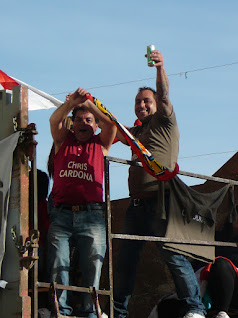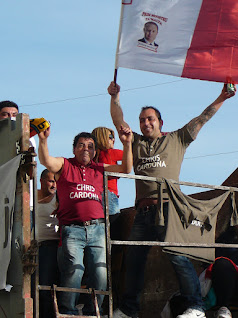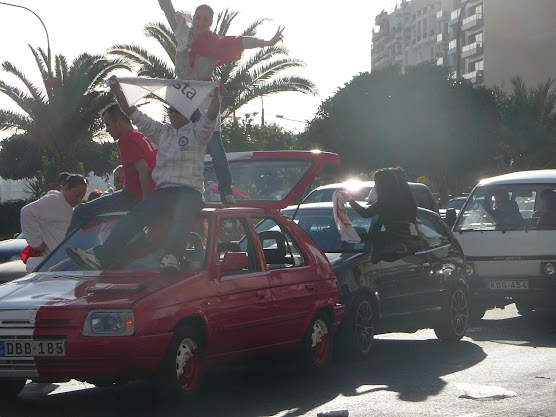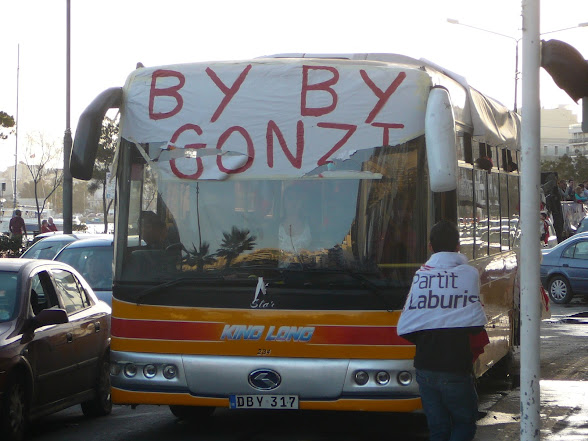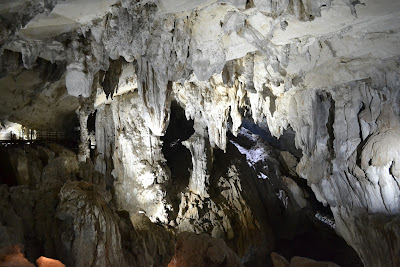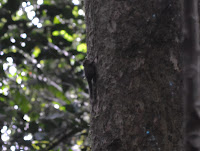Remember that part in BBC's
Planet Earth where the cameraman had to
wade through thick, steaming piles of bat shit and cockroaches in a dark cave?
Well, that's where I was going! And I don't think I've ever been so excited to
see piles of shit, literally! Dad and I were booked on a 4 day, 3 night tour at
the world heritage site Gunung Mulu National Park, and I couldn't wait (and
neither could dad wait to stick his foot in the shit either... see later in the
story).
The flight to Mulu from Miri was a relatively short 40min, flying over the
rainforest and jungle of Borneo, watching rivers lazily snake their way through
the rainforest, with a few oxbow lakes (A-level geography coming into play
here). I was squealing with excitement all the way throughout the flight, still
couldn't believe that I was going to the jungles of Borneo, one of the most
biologically diverse ecosystems on Earth. The Borneo rainforest is one of the
only place in southeast Asia where tropical rainforests can be conserved on a
grand scale. This rainforest is one of the oldest rainforest in the world, some
130 million years old. As for the flora and fauna, the stats are enough to
leave you gobsmacked. There are about 15,000 species of flowering plants alone,
not to mention the trees, ferns, mammals, birds, etc. And scientists haven't
even finished discovering all the species! Suffice to say, Borneo's rainforest
is a mecca for ecologists.

Once at the lodge we met up with our guide, Lucy, a Mulu native from the
Berwan tribe. Our first trip out was to the Deer and Lang caves to see the bats
flying out at dusk. Deer Cave contains the world's largest cave passage open to
tourists, over 2km in length and 174m in height. Apparently it can hold London
St. Paul's Cathedral five times over! It is also home to swiftlets and several
millions of bats (naked, wrinkle-lipped, and horseshoe bats), plus lots of
other creepy crawlies.
Swiftlet in a nest - the nest (made of the swiftlet's saliva) is what is used in the famous bird's nest soup.
One of the Deer Cave bats, although no idea which species it is.
To reach the bats we had an easy 3km walk along a boardwalk from the park
headquarters. This was like an introduction to the Borneo jungle. I managed to
take photos of some interesting flora and fauna unfortunately most of them came
out blurred :-( mainly due to using a telephoto lens on a bouncy boardwalk with
no tripod. However here are a few photos of what we saw along the way.
Random lizard.
Male millipede being carried by the female (bloody males, even in the insect world!). Apparently though it's the male millipede's way of relaxing the female to convince her to mate.
Part of a fern that is edible and tastes rather nice, the locals stir fry it with different oils and spices.
I managed to see the Borneo Pygmy Squirrel but unfortunately I didn't have
my zoom lens set up on my camera so I didn't manage to get a clear picture of
it. Here's the best pic I got of it. Oh, and they are sooooo cute! It is only
one of the smallest squirrel around and endemic to Borneo. I really had to
resist the urge to bring one back with me.
Below are some pics of interesting plants. The one on the bottom is fresh pepper.
The highlight of the excursion was, of course, the caves. We started at Lang
Cave, with its beautiful stalactite and stalagmite formations, scalloping and
karst formations before moving onto Deer Cave. These formations, as well as the
caves, are formed by high volumes of rainfall and subterranean rivers eroding
away the limestone of the area. Essentially Mulu has the largest cave chamber
(Sarawak chamber), largest cave by volume (Deer cave), larges passages (Deer
cave), and in the top ten longest cave (Dear cave linking with Lang cave and
the Clearwater system). Nowhere in the world are so many large features so
visible and accessible.

Another
organism of interest we saw at Lang Cave was the cave glow worm. As the worm
is very slow moving it secretes silk tendrils (snares) covered with mucus as
traps for flying insects. Each worm can secrete up to about 30 snares, forming
a beautiful, artistic picture, especially when light is shone on the snares.
Unfortunately my photos below do not do the worms justice.
You knew when you were approaching Deer cave from the acrid smell that
emerged due to the large amounts of bat poo (i.e. guano) deposited in the cave.
Well, a million or so bats will produce lots of shi... err, I mean guano! Not
forgetting all the swiftlets in there. Actually the bat guano plays an
important part in the whole cave foodweb. Due to lack of light in the cave all
the insects depend upon the organic richness present in the guano. Oh yeah, and before I forget, dad managed to sink ankle deep into the guano! Hehe, obviously he wanted to to get up close and personal to some bat poo :-)
Some photos of Deer cave below. Apologies for
placing the photos below each other, haven't quite figured out the html code on
how to place the photos side by side and have already spent enough time
googling it and trying to figure it out. What I couldn't manage to photo were
the huge mound of bat guano, some mounds at least 10m high! Although not as
high as the 100m filmed for Planet Earth at Gomantong Caves in Sabah. I really
wanted to try and get a picture record of the guano and all the insects
(including cockroaches) found in the guano.



However,
despite the beauty of the cave, the piece de resistance was watching the bats
fly out of the cave at dusk. Thousands upon thousands of bats exit Deer cave at
dusk to go forage for food before returning at dawn. For me this was
particularly exciting as I normally help out the terrestrial ecologists at work
with bat surveys back in the UK, including emergence surveys. I normally get
excited seeing three or four bats emerge from a farm building during my
surveys, let alone thousands! Sat in the bat-watching mini-amphitheatre I
couldn't help feeling like a little excited kid. And when the bats finally
emerged, all I could say is wow! A couple thousand bats emerged at each wave,
flying out of the cave entrance and up the sheer cliffside before flying
towards the jungle in a neat corkscrew fashion. This went on for at least half
an hour before the number of bats finally started dwindling.
Obviously I took far too many photos, all of them pretty much looking the same, and turning into a pain in my neck to sort them all out. Hopefully the photos below convey the sheer amount and beauty of the merging bats.
The cave entrance and where the majority of the bats flew out of.
The corkscrew path that each wave of bats took as they flew across the sky towards the jungle.
An alternative bat formation to that of the corkscrew.
A close up of the sheer numbers of bats that emerge each evening.
All in all Day 1 at Mulu proved to be all I hoped for an more, and I couldn't wait for what the next day had in store for us. Finally, to finish off a few photos for the family and one cheeky toad!
All hot and sticky before the start of the walk.
Walking along the boardwalk with our guide Lucy.
Dad trying to get phone signal at our resort room.
Found this little guy calling his heart out on the walk back to the resort from the caves. I believe he's Ingerophrynus divergens but please do correct me if I'm wrong.





